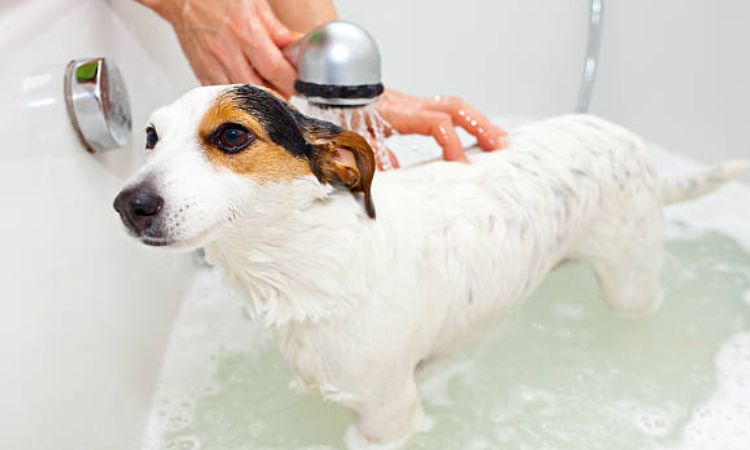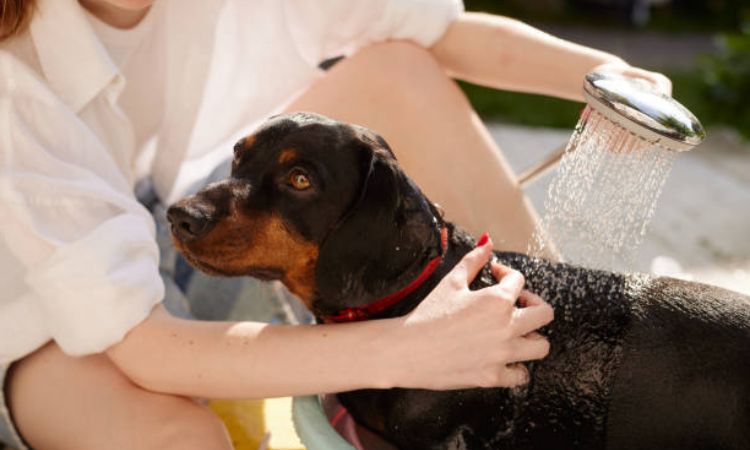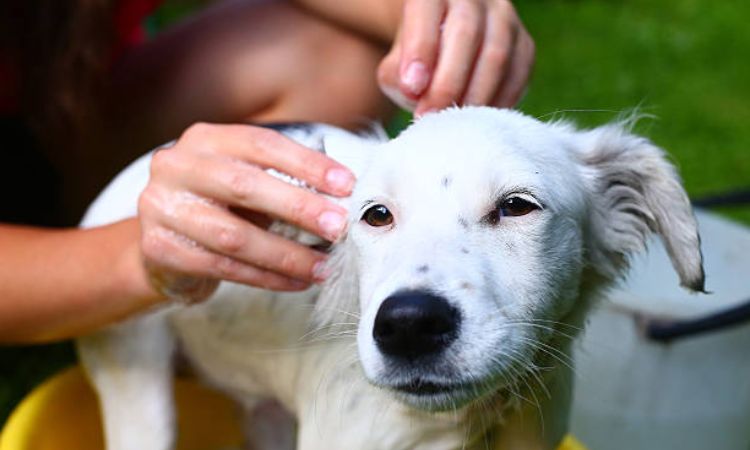Bath time for your dog isn’t just about keeping them smelling fresh it’s a crucial part of maintaining healthy skin and a shiny coat. While many dogs do just fine with a monthly bath, some pups may need more frequent washes, and others less, depending on their breed, lifestyle, or any skin sensitivities.
Curious how often your furry friend should hit the tub? Keep reading for a complete guide covering everything from seasonal changes and allergies to pesky fleas.
Section 1: The General Guidelines for the Average Dog

1. The Standard Rule of Thumb
For the average, healthy dog, bathing every 4–8 weeks is a generally accepted guideline. This schedule keeps your dog clean without disrupting the natural oils in their coat, which are critical for protecting the skin and maintaining a shiny, healthy appearance.
- Why it works: Dogs produce natural oils (sebum) that help waterproof their coat and maintain skin health. Bathing too infrequently can lead to dirt buildup, odors, and matting. Bathing too frequently can strip these oils, causing dry, flaky skin.
- Frequency in practice:
- A typical indoor dog might only need a bath every 6–8 weeks.
- Active outdoor dogs or those prone to odors (rolling in mud, swimming, hiking) may benefit from monthly baths.
Quick tip: Let your dog’s nose and your instincts guide you. If your pup smells “doggy” or has visible dirt, it’s time for a wash—even if it’s ahead of schedule.
2. The Danger of Over-Bathing
Bathing a dog too often can do more harm than good. Excessive washing removes natural oils that protect the skin, leading to:
- Dry, itchy, and irritated skin
- Flaking and dandruff
- Exacerbation of skin conditions (allergies, dermatitis)
- Stripping of flea/worm treatment if using topical medications
Pro tip: For lightly soiled dogs, a water-only rinse can refresh their coat without stripping oils. Save full shampoo baths for when your dog is actually dirty or has developed an odor.
3. Coat Type and Length Matters
Not all dogs need the same bathing schedule. Coat type, hair length, and oiliness play a huge role in determining frequency.
| Coat Type / Breed | Bathing Frequency | Notes |
| Short-haired breeds | Every 6–8 weeks | Low-maintenance, natural oils protect skin, easy to brush out dirt. |
| Long-haired breeds | Every 4–6 weeks | Susceptible to tangles and mats; brushing between baths is crucial. |
| Double-coated breeds | Every 6–8 weeks | Bathing is less important than regular de-shedding and brushing. |
| Oily or odor-prone breeds | Every 3–4 weeks | Breeds like Cocker Spaniels, Basset Hounds, or active outdoors dogs benefit from more frequent washing. |
| Hairless breeds | Weekly or biweekly | Skin is exposed; prone to dryness, infections; use gentle/hypoallergenic shampoo. |
Section 2: Bathing a Dog with Skin Allergies
For dog owners asking, “how often should I bathe my dog with skin allergies?”, the answer is different from a typical bathing schedule. Dogs with allergic skin conditions require special attention, and a carefully planned bath routine can make a significant difference in their comfort and healing.
Allergies whether caused by environmental factors like pollen and dust, or food sensitivities can lead to itchy, inflamed skin and increase the risk of secondary bacterial or yeast infections. Regular, targeted bathing is one of the most effective ways to manage these symptoms, as it helps remove allergens from the skin, soothes irritation, and reduces inflammation.

1. The Role of Medicated Shampoos
Medicated shampoos are a critical tool for dogs with skin allergies. These shampoos are specifically formulated to:
- Flush allergens from the skin and coat
- Rehydrate and protect the skin barrier
- Reduce itching, redness, and irritation
- Control bacterial or yeast overgrowth
Using a medicated shampoo correctly can significantly improve your dog’s skin health, but frequency and shampoo type should always be guided by a veterinarian. Some shampoos are designed for daily use during flare-ups, while others are milder and used weekly or biweekly. Over-washing with the wrong product can strip essential oils and worsen dryness or irritation, so veterinary guidance is essential.
2. Standard Allergic Dog Frequency
Veterinarians typically recommend the following routine for dogs with allergic skin conditions:
- During flare-ups: Baths once a week using a vet-approved medicated shampoo. This helps control itching, soothe inflammation, and remove allergens and debris that exacerbate the condition.
- Maintenance phase: Once the acute symptoms are under control, bathing can often be reduced to every two to four weeks, depending on the dog’s coat type, lifestyle, and ongoing skin health.
It’s also important to follow instructions regarding contact time. Many medicated shampoos need to remain on the skin for 5–10 minutes to be fully effective. During this time, gently massage the shampoo into the affected areas, but monitor your dog for signs of discomfort or stress.
Section 3: Seasonal Adjustments: Winter Bathing
1 Why Winter is Different
Winter air tends to be dry, and indoor heating further reduces humidity, which can lead to dry, flaky skin in dogs. Over-bathing during the colder months can strip away the natural oils that protect their skin, leaving it itchy and vulnerable to irritation.
Dogs also encounter salt, ice melt, and slush on sidewalks and roads, which can irritate paws and coat. Rather than bathing after every walk, focus on quick paw rinses and wiping down their legs and belly to remove these irritants while preserving essential oils. This approach helps keep your dog clean without over-washing during a season when their skin is more sensitive.
2 Essential Winter Bathing Tips
To maintain a healthy coat and skin during winter, follow these key practices:
- Use Lukewarm Water Only: Cold water can be a shock to your dog, while hot water can dry out their skin. Aim for water around 100–102°F (37.8–38.9°C).
- Ensure Complete Drying: After the bath, towel-dry thoroughly and, if needed, use a pet-safe hair dryer on a low, warm setting. Never allow your dog to go outside wet in cold weather, as this can chill them and exacerbate skin dryness.
- Use Moisturizing or Hydrating Shampoos/Conditioners: Winter-specific dog shampoos help maintain natural oils and hydration. Avoid human shampoos, which can strip protective oils and irritate sensitive skin. A leave-in conditioner or hydrating spray can further protect your dog’s coat between baths.
By adjusting your dog’s bathing routine to winter conditions and prioritizing hydration and protection, you can help your pet stay clean, comfortable, and healthy throughout the colder months.
Section 4: Urgent Care: Bathing for Flea Infestation
When fleas strike, fast action matters. Many owners urgently search how often should I bathe my dog with fleas, but it’s important to understand that while bathing is the first step, it’s not a standalone solution.

1. The Immediate Protocol
If your dog has visible fleas, bathe them right away using a flea shampoo or, in an emergency, mild dish soap to kill adult fleas on contact. Because flea eggs and larvae continue to hatch over time, another bath may be necessary:
- Initial bath immediately
- Second bath 2–3 days later
- Optional third bath within the same week, depending on severity
This short-term bathing schedule helps eliminate newly emerged fleas. However, baths only kill the fleas currently on your dog—they do not provide lasting protection or stop reinfestation from the home environment.
2. Post-Bathing Treatment
Once your dog is fully dry, follow up with a veterinarian-approved flea preventative, such as:
- A spot-on topical that spreads across the skin’s oils
- A chewable oral medication that disrupts the flea life cycle
This step is non-negotiable. Without ongoing protection, fleas in your home, yard, or on other pets will jump right back onto your dog.
Baths remove fleas in the moment. Preventatives keep them from coming back.
To ensure complete flea control, pair your dog’s treatment with a household and yard cleanup plan to eliminate eggs and larvae hiding in the environment.
Keeping your dog comfortable and healthy means adjusting their bathing routine to match real-world needs—whether that’s managing skin allergies, staying clean during the winter months, or tackling a sudden flea problem. Paying attention to their coat condition, using the right products, and following veterinary guidance will help protect their skin’s natural barrier and support long-term wellness. Every dog is different, but with the right approach, bath time becomes more than just cleaning—it becomes an essential part of caring for the dog you love.






